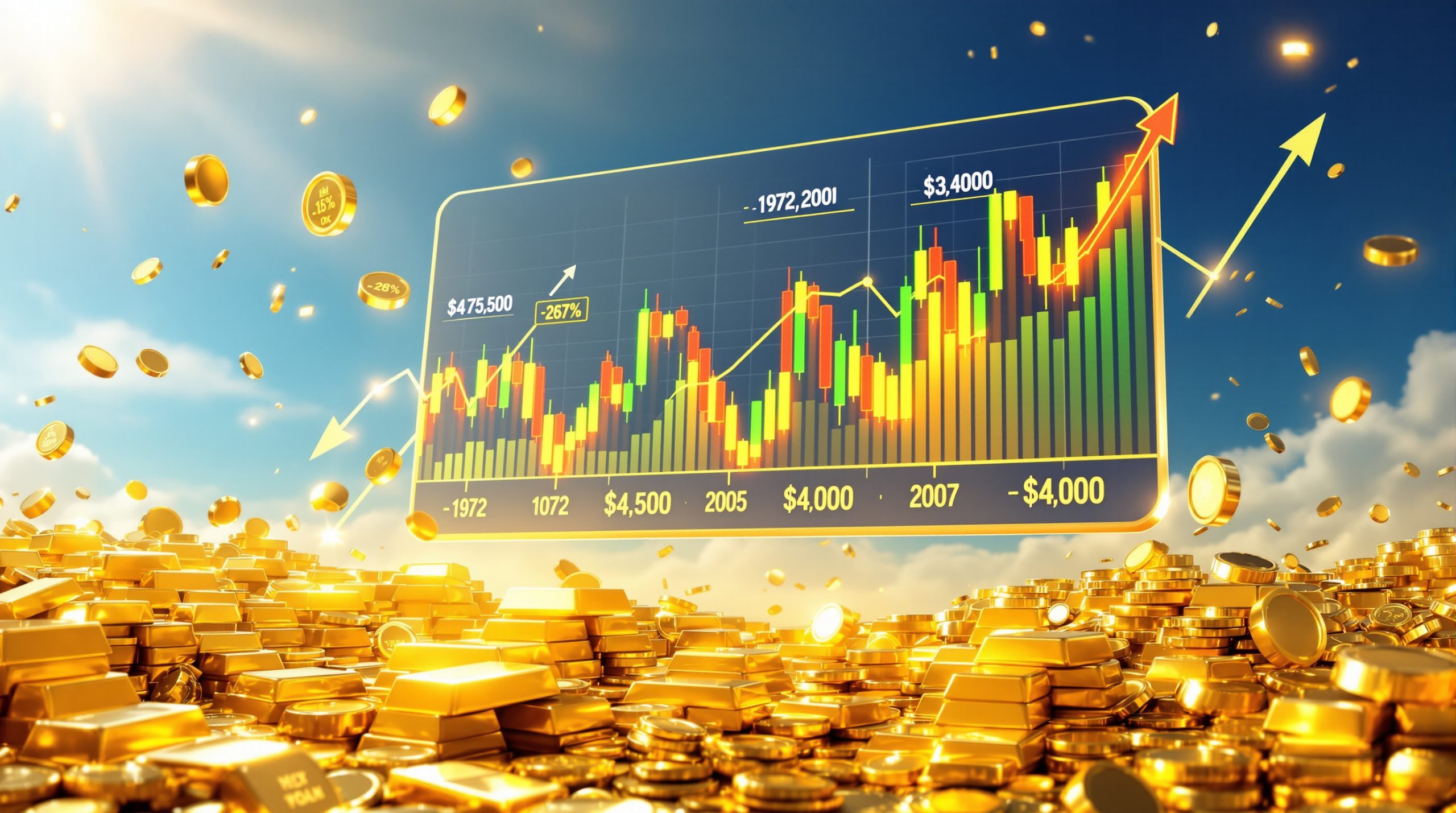What Drives Gold Price Fluctuations? Understanding Market Dynamics
Gold has fascinated humanity for millennia, serving as both a symbol of wealth and a trusted store of value during uncertain times. Whether held as jewelry, bars, coins, or in investment portfolios, this precious metal continues to captivate investors worldwide. However, gold prices rarely remain stable, often exhibiting significant volatility. Understanding the factors that influence why do gold prices go up and down is essential for anyone considering gold as an investment.
The Dual Nature of Gold: Commodity and Financial Asset
Gold occupies a unique position in the financial world as both a physical commodity and a monetary asset. This dual nature means its price responds to a complex interplay of factors that other assets don't experience, creating a distinctive price behavior pattern that investors must understand.
How Does Inflation Impact Gold Prices?
Gold as an Inflation Hedge
Gold has historically served as a premier inflation hedge. When inflation rises, paper currency loses purchasing power, prompting investors to seek tangible assets that maintain value. Gold fulfills this role effectively because:
- It's priced internationally in dollars, insulating it from any single country's monetary policy
- It has maintained purchasing power over centuries
- It cannot be devalued through printing like fiat currencies
During the 1970s inflation crisis, gold prices skyrocketed from approximately $35 per ounce in 1970 to around $850 by January 1980—a staggering 2,300% increase as investors fled rapidly devaluing currencies. More recently, the extensive global monetary stimulus following the COVID-19 pandemic renewed inflation concerns, contributing to gold's price forecast surge from around $1,500 in early 2020 to over $2,000 by August of that year.
Expert Insight: "Gold's performance during inflationary periods stems from its universal recognition as a store of value that central banks cannot debase through monetary expansion—a critical characteristic when fiat currencies lose purchasing power." – World Gold Council
The Relationship Isn't Always Straightforward
While gold often rises during inflationary periods, the correlation isn't perfectly linear or immediate. Market expectations about future inflation can sometimes influence prices more than current inflation rates. Additionally, other factors like interest rates can temporarily override inflation's impact on gold prices.
Research by the Federal Reserve Bank of Cleveland has shown that gold responds more strongly to unexpected inflation shocks than to gradual, anticipated inflation—explaining why sudden inflation fears can trigger rapid price movements even before inflation actually materializes in economic data.
What Role Does the US Dollar Play in Gold Pricing?
The Inverse Relationship
Gold is primarily priced in US dollars globally, creating a significant inverse relationship between dollar strength and gold prices:
- When the dollar strengthens: Gold becomes more expensive for buyers using other currencies, potentially reducing demand and pressuring prices downward
- When the dollar weakens: Gold becomes more affordable for international buyers, potentially increasing demand and supporting higher prices
This relationship explains why gold often moves opposite to dollar strength indicators like the DXY index. For example, when the DXY fell approximately 10% between March and December 2020, gold prices rose nearly 25% during the same period.
Currency Exchange Considerations
For major gold producers like Australia (the world's second-largest producer with annual output exceeding 300 tonnes), the AUD/USD exchange rate adds another layer of complexity. A weaker Australian dollar can benefit domestic producers by increasing the local currency value of their gold production, even if USD gold prices remain stable.
The Reserve Bank of Australia closely monitors this relationship, as mining contributes significantly to Australia's export earnings. When the AUD/USD rate fell from 0.70 to 0.55 during the March 2020 market turmoil, Australian gold miners saw their domestic-currency revenues surge even as global markets panicked.
How Do Interest Rates Affect Gold Prices?
The Opportunity Cost Factor
One of gold's key characteristics is that it generates no yield—it pays no dividends, interest, or coupons. This creates an opportunity cost for holding gold instead of yield-bearing assets:
- When interest rates rise: Bonds and savings accounts become more attractive alternatives, potentially reducing gold demand
- When interest rates fall: The opportunity cost of holding gold decreases, potentially increasing its appeal
This relationship was particularly evident during 2022, when the Federal Reserve's aggressive rate hikes (raising rates from near-zero to over 5%) coincided with gold struggling to maintain its gains despite high inflation.
Real Rates Matter Most
The relationship between gold and interest rates is most pronounced when examining real (inflation-adjusted) interest rates:
- Negative real rates (when inflation exceeds nominal interest rates) typically benefit gold prices
- Positive real rates often create headwinds for gold
This explains why gold performed strongly during recent periods of ultra-low interest rates combined with rising inflation concerns, as real rates turned negative in many economies. The correlation coefficient between gold prices and the yield on 10-year Treasury Inflation-Protected Securities (TIPS)—a proxy for real interest rates—has consistently been around -0.8 to -0.9, indicating a strong inverse relationship.
Historical Context: Between 2019 and 2021, when real yields on 10-year US Treasuries fell from +0.14% to -1.1%, gold prices rose approximately 40%, demonstrating this inverse relationship in action.
How Do Geopolitical Events Influence Gold Prices?
The Safe-Haven Effect
Gold's reputation as a safe-haven asset becomes particularly evident during periods of geopolitical instability:
- During wars, political crises, or trade tensions, investors often flock to gold
- Financial market turbulence typically triggers increased gold buying
- Banking system concerns can prompt investors to seek assets with minimal counterparty risk
During the 2008-2009 global financial crisis, gold prices surged from around $730 in October 2008 to over $1,900 by September 2011—a 160% increase as investors sought stability amid plummeting stock markets and banking system fears. More recent events like conflicts in Eastern Europe and US-China trade tensions have triggered similar safe-haven buying, with gold jumping 8% in the first quarter of 2022 as the Ukraine conflict escalated.
The Psychology Behind Crisis Investing
The psychological forces driving gold during crises include:
- Fear of systemic financial collapse
- Desire for assets with intrinsic value
- Preference for investments with limited counterparty risk
- Historical trust in gold's ability to preserve wealth through turbulent times
These psychological factors often create a self-reinforcing cycle during crises: as uncertainty increases, gold buying accelerates, pushing prices higher and validating the safe-haven narrative, which then attracts additional investors.
How Does Gold Supply Affect Market Prices?
Mining Production Dynamics
Unlike many commodities, gold supply grows very slowly due to:
- Resource depletion in existing mines
- High costs and long lead times for new mine development
- Environmental and regulatory constraints on mining operations
Global mine production adds only about 1-2% annually to the total above-ground gold stock (estimated at approximately 205,000 tonnes). Major gold producers include Australia (producing around 310 tonnes annually), China (370 tonnes), Russia (330 tonnes), and the United States (230 tonnes). Production disruptions in these regions—whether from operational problems, labor disputes, or regulatory changes—can tighten supply and potentially support higher prices.
Industry Insight: "The average time from gold discovery to production has stretched to nearly 20 years, creating significant supply inelasticity in response to price increases." – Mining Industry Council
The Recycling Factor
Recycled gold (from jewelry, electronics, and other sources) constitutes a significant portion of annual supply—approximately 25-30% in recent years:
- Higher gold prices typically increase recycling activity as holders are incentivized to sell
- Lower prices generally reduce the flow of recycled gold into markets
- This creates a natural stabilizing mechanism in the gold market
During price spikes, this recycling response can help moderate further increases by bringing additional supply to market relatively quickly compared to the years required for new mining projects.
Central Bank Reserves and Policies
Central banks collectively hold approximately 35,000 tonnes of gold reserves (about 17% of all above-ground gold), making them major market participants:
- Net buying by central banks (particularly in emerging economies like Russia, China, and India) can significantly impact available supply
- Central bank selling programs can increase market supply and pressure prices
- Policy shifts regarding gold reserves often signal changing attitudes toward the metal's monetary role
Recent years have seen consistent net buying from central banks, with record purchases of 1,136 tonnes in 2022 according to the World Gold Council. This trend represents a dramatic shift from the 1990s and early 2000s when central banks were net sellers of gold, and has provided substantial support to prices by restricting market supply.
| Year | Central Bank Net Purchases | Impact on Gold Market |
|---|---|---|
| 2022 | 1,136 tonnes | Strongest demand since 1967 |
| 2021 | 463 tonnes | Continued long-term buying trend |
| 2020 | 255 tonnes | Reduced but positive amid pandemic |
| 2019 | 650 tonnes | Second-highest annual total in recent decades |
How Do Market Speculation and Investment Flows Impact Gold?
Beyond Physical Gold: Financial Instruments
Today's gold market extends far beyond physical bullion to include:
- Futures contracts (with daily trading volumes often exceeding annual mine production)
- Exchange-traded funds (ETFs) holding over 3,000 tonnes collectively
- Mining company shares
- Options and other derivatives
These financial instruments enable significant speculative activity that can drive short-term price movements independent of physical supply-demand fundamentals. For instance, COMEX gold futures regularly see daily trading volumes equivalent to thousands of tonnes—far exceeding the physical gold actually changing hands globally.
ETF Flows as a Price Indicator
Gold-backed ETFs have become particularly influential:
- Large inflows to gold ETFs typically support higher prices
- Outflows often coincide with price weakness
- These investment vehicles make gold exposure more accessible to mainstream investors
The relationship between ETF flows and prices was dramatically demonstrated in 2020, when global gold ETFs added 877 tonnes (worth approximately $48 billion) to their holdings while gold market performance gained 24%. Conversely, in 2021, ETF outflows of 173 tonnes coincided with gold's price decline despite rising inflation.
Algorithmic Trading Impact
Modern markets feature extensive algorithmic trading that can:
- Amplify price movements in either direction
- Create temporary disconnects between gold and traditional correlations
- Generate short-term volatility unrelated to fundamental factors
Research from market liquidity providers indicates that algorithms now account for over 60% of gold futures trading volume in some sessions, with particular concentration around key technical levels and economic data releases.
How Do Cultural and Seasonal Factors Affect Gold Demand?
Cultural Significance in Key Markets
Gold holds profound cultural importance in countries like India and China, where it's associated with:
- Religious ceremonies and festivals
- Wedding traditions
- Symbols of prosperity and security
- Intergenerational wealth transfer
India alone accounts for approximately 25% of global gold jewelry demand, with annual consumption typically ranging between 500-800 tonnes. Similarly, China represents about 30% of global jewelry demand, consuming over 600 tonnes annually in recent years.
Seasonal Demand Patterns
These cultural factors create predictable seasonal demand patterns:
- Indian wedding season (October-December) typically sees gold demand spike 30-40% compared to quarterly averages
- Festivals like Diwali and Akshaya Tritiya can drive single-day gold purchases exceeding 20 tonnes
- Chinese New Year celebrations typically boost Q1 demand in China by 25-35%
- Western holiday gift-giving seasons create modest demand increases in December
These events can create temporary demand surges that influence global prices, particularly when they coincide with other bullish factors. The World Gold Council reported that Indian gold demand reached 266 tonnes in Q4 2023, heavily concentrated around the Diwali festival period.
Market Insight: "The predictable nature of festival-related gold buying in India and China creates seasonal trading opportunities, but these cultural demand patterns can be overwhelmed by investment flows during periods of economic uncertainty." – Precious Metals Analyst
Why Is Gold Price Volatility Often Surprisingly High?
Despite its reputation for stability, gold can experience significant price volatility due to:
- Its dual role as both commodity and financial asset
- High liquidity in futures and ETF markets enabling large position changes
- Sensitivity to multiple economic indicators and geopolitical developments
- Changing investor sentiment regarding inflation and currency stability
This volatility makes timing gold investments challenging but also creates opportunities for strategic positioning. Gold's daily price volatility has averaged around 1.2% over the past decade—higher than many government bonds but lower than most equities and commodities.
The CBOE Gold Volatility Index (GVZ), which measures expected 30-day volatility in the gold market, has regularly spiked above 30 during crisis periods (compared to its typical range of 10-15), indicating that market participants anticipate substantial price movements during times of uncertainty.
What Does This Mean for Investors?
Gold's Role in a Portfolio
Understanding why do gold prices go up and down helps investors position the metal appropriately in their portfolios:
- As portfolio insurance against inflation, currency devaluation, and market crises
- As a diversification tool with different performance characteristics than stocks and bonds
- As a potential tactical investment during specific economic conditions
Research by leading portfolio managers suggests that a gold-stock market guide allocation of 5-10% has historically improved risk-adjusted returns for balanced portfolios, particularly during periods of market stress.
Timing Considerations
While perfect timing is impossible, investors can make more informed decisions by monitoring:
- Central bank policies regarding interest rates and monetary stimulus
- Inflation trends and expectations (particularly breakeven inflation rates)
- Currency movements, particularly the US dollar
- Geopolitical developments
- Investment flows into gold ETFs and similar vehicles
Professional investors often focus on the ratio of gold to other assets (like the Dow-to-Gold ratio or Gold-to-S&P 500 ratio) as valuation metrics to identify potential entry and exit points based on historical relationships.
FAQs About Gold Price Fluctuations
Why does the US dollar have such a significant impact on gold prices?
Since gold is priced in US dollars globally, a stronger dollar makes gold more expensive for foreign buyers, potentially reducing demand and pressuring prices. Conversely, a weaker dollar makes gold more affordable internationally, potentially increasing demand and supporting higher prices. The correlation coefficient between gold and the DXY dollar index typically ranges from -0.4 to -0.6, confirming this inverse relationship.
How do rising interest rates affect gold?
Higher interest rates increase the opportunity cost of holding non-yielding assets like gold. As interest-bearing investments become more attractive, some investors may shift away from gold, potentially reducing demand and pressuring prices downward. This relationship is particularly strong when real (inflation-adjusted) interest rates rise, as demonstrated by gold's 15% decline during the Fed's aggressive tightening cycle in 2022.
Can geopolitical risks cause sudden gold price spikes?
Yes, during wars, trade disputes, or political unrest, investors often seek safe-haven assets like gold, which can drive prices sharply higher in short periods. This "crisis premium" typically reflects fear-driven demand rather than fundamental changes in supply. Gold jumped approximately 6-8% in the immediate aftermath of significant geopolitical events like the 2001 terrorist attacks, the 2003 Iraq War, and the 2022 Ukraine conflict.
Does mining supply significantly limit gold price growth?
Mining supply grows slowly and steadily, typically adding only 1-2% to above-ground gold stocks annually. This means short-term price fluctuations are driven more by demand factors and investor sentiment than by supply shocks, though long-term supply constraints do provide underlying price support. The total cost of production (including capital expenditures) for major miners averages $1,000-1,200 per ounce, establishing a rough floor for sustainable long-term prices.
What role do central banks play in gold prices?
Central banks' buying or selling of gold reserves can significantly influence market supply and signal confidence in the metal. Recent years have seen consistent net buying from central banks, particularly in emerging economies, which has supported prices by restricting available market supply. Central bank purchases reached a record 1,136 tonnes in 2022—equivalent to approximately 25% of annual mine production—demonstrating their substantial market impact.
Disclaimer: Gold prices are subject to significant volatility and influenced by numerous factors beyond those discussed in this article. Past performance is not indicative of future results. Investors should conduct their own research or consult financial advisors before making investment decisions based on this information.
Want to Capitalise on the Next Major Gold Discovery?
Don't miss potential opportunities in the gold sector with Discovery Alert's proprietary Discovery IQ model that instantly notifies investors about significant ASX mineral discoveries, turning complex data into actionable insights. Explore how major gold discoveries can lead to significant market returns by visiting the dedicated discoveries page and start your 30-day free trial today to position yourself ahead of the market.




